by Darryl Kelly
Note: This story of Bill Webb is reprinted from the book Just Soldiers- Stories about ordinary Australians doing extraordinary things in time of war. Details of this 288 page book, written by Darryl Kelly and published by the ANZAC Day Commemoration Committee of Queensland, can be found here.
Footnotes: Numerals appearing in brackets eg (1) in the text indicate that a footnote relevant to that text is provided at the end of the document.
In 1939, war clouds once more hung over Europe. Poland had been invaded and the German forces were rampaging across the Low Countries. It was not long before Great Britain was forced to declare war on Germany, calling upon all countries of the British Empire to support the Mother Country. Again, Australia was going to war.
On 7 March 1941, William Purnell Webb -- a 44-year-old WW1 veteran -- presented himself at the Maryborough enlistment office. He was over age, but he was an old soldier who knew the ropes, so he was able to talk his way back into uniform. He was allocated to the 3rd Reserve Motor Transport Company, which was part of the Australian 8th Division.(1)
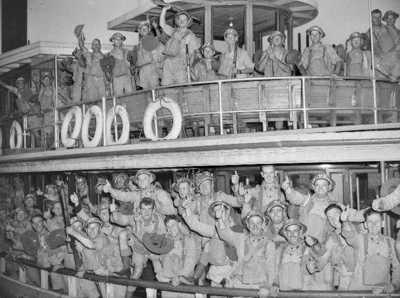
Like to copy this image? Please click here first
AWM 006967. Sydney, NSW. 14 February 1941. Members of the 2/3rd Motor Ambulance Convoy and the 3rd Reserve Motor Transport Company being ferried to their assigned ship which is waiting to transport them to Malaya.
As the convoys of the Division set sail, talk of their impending action against the Germans and Italians in North Africa was widespread among the ranks. Little did they know it was not the sands of Egypt, but the jungles of Malaya that awaited them.
Timed to coincide with the raid on Pearl Harbour, the Japanese orchestrated simultaneous attacks on the Allied bases in the South West Pacific. To assault the British forces in Malaya, the Japanese struck the north-east coast, landing some twelve thousand troops at Kota Bahru, the capital of Kelantan and the base of operations for the Royal Air Force. Despite strong opposition from the defenders, the Japanese soon gained the upper hand, and, with command of the skies, they pushed their way south through the all but impenetrable jungles of the Malayan peninsula.
In early February 1942, the retreating Allied forces crossed the causeway to what many called ‘Fortress Singapore’. The Japanese were relentless in their determination to seize the island and threw everything they had at the beleaguered garrison. Japanese troops crossed the narrow straits in force on 8 February 1942. Webb had to watch the battle from his hospital bed where he was suffering a bout of malaria and a 104°F fever.(2)
In the closing days of the battle, a rumour spread through the wards that the Japanese had captured a nearby hospital and bayoneted the patients in their beds. Bill Webb was not about to lie there and wait for it to happen to him. Changing back into his uniform, he left the hospital to find his unit, confident that if he had to die, then he would die fighting. He learned that his unit was somewhere near the docks, but reaching them would not be easy as the area was under constant bombardment, both from the ground and the air.
When he finally reached the harbour, he found ships of every size and shape being loaded to the gunnels with civilians and military personnel alike. As he made his way along the dockside, Webb was grabbed by a military policeman who pushed him towards the gangway of the nearest vessel. ‘Get on the ship mate, or the Japs will have you in the bag’, he ordered.
As the ship pulled away from the dock, Webb asked a soldier nearby, ‘Are we going to Australia?’ ‘No mate, we’re heading for Java.’
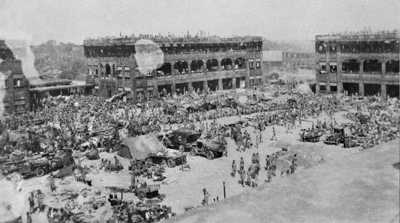
Like to copy this image? Please click here first
AWM 132937. AIF and British POWs, Selarang Barracks, Changi, Singapore, 9 Feb 1942. Troops arriving in Selarang Barracks Square following fall of Singapore.
Following the fall of Singapore, the Japanese focus switched to the islands of the Dutch East Indies. Facing the onslaught was a mixed bag of British, Dutch, Australian and American troops who mounted a futile and eleventh-hour bid to slow the Japanese juggernaught as it moved closer to what many believed was its next objective -- Australia.
At home, the fall of Singapore was having an unsettling effect on the whole country, particularly on the families of the troops who had gone to Malaya. As she hung the washing on the line, Gladys Webb froze at the sight of the telegram delivery boy peddling down the street. She closed her eyes and prayed, ‘Please don’t stop. Please God, don’t let him stop here.’ A young voice interrupted her reverie. ‘Mrs Webb?’ She opened her eyes, nodded her head in response to the boy’s question and took the envelope he handed to her. As she opened it, one word stood out like a beacon, ‘missing’.
Bill Webb was now a prisoner of war. He was one of the twenty-two thousand Australians who were captured defending Malaya, Singapore, and the Dutch East Indies. As ‘guests of the Emperor’ the prisoners were confronted by disease, deprivation and appalling brutality at the hands of their captors.
Bill resolved to make the best of a horrendous situation. His prime objective was survival and he became renowned for his forays beyond the wire in search of food. Unfortunately for Bill, there was worse to come. Labour was needed to build a railway to carry supplies between Thailand and Burma -- it would later be referred to as the ‘Railway of Death’.
Working under unbearable conditions, the Allied prisoners not only had to contend with the brutal treatment dished out by the Japanese and Korean guards, but had to battle all manner of tropical diseases, lack of shelter, 16-hour work days and a near starvation diet. Webb’s will to survive never wavered. He would creep out of camp at night and trade with the local natives for food. He was well aware of the consequences if caught, but knowing that extra food gave him a better chance of staying alive made it worth the risk.
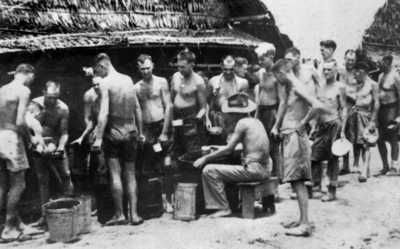
Like to copy this image? Please click here first
AWM 128455. Mess parade for prisoners of war of the Japanese at a camp on the Burma–Thailand Railway. In theory the Japanese ration scale for POWs on the railway included 680 gm of rice, 520 gm of vegetables and 110 gm of meat or fish per man per day. At one stage at the 105 km camp in Burma, the rations were so short that meals consisted of rice and boiled chilli water.
In October 1943, fourteen months after construction had commenced, the Thailand and Burma ends of the 265-mile-long railway (420 km) were joined at Konkoita and the work was finally completed. The cost in human lives was inconceivable -- more than 12,000 Allied prisoners and 70,000 Asian labourers had died. Some 13,000 Australian POWs had been sent to work on the railway -- the dead numbered 2646, ten for every mile of track.(3)
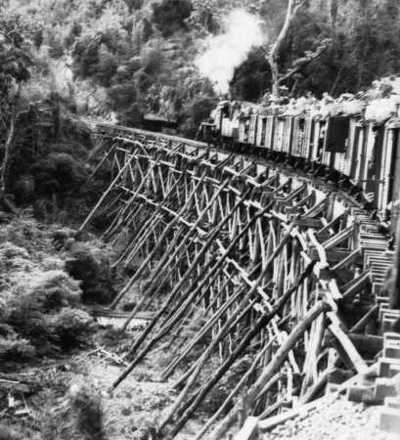
Like to copy this image? Please click here first
AWM 122309. This bridge, approximately one km south of Hintok Station, was one of six trestle bridges between Konyu (Hellfire Pass), 152 km north of Nong Pladuk, and Hintok, 155 km north of Nong Pladuk.
In March 1944, seven thousand Australian POWs assembled on a bare dirt parade ground at Tamarkan, Thailand. Starvation had reduced the Diggers to mere skeletons with sunken eyes, bodies covered in festering open sores; many were wracked by malaria, dysentery and beriberi. The Japanese commander stood on a box to address the prisoners. ‘All fit men go Nippon’, he told them.
Nine hundred ‘fit’ men were chosen, including Corporal Bill Webb. They were organised into six groups -- called kumis -- each comprising 150 men. The prisoners were taken by rail to Bangkok and Phnom Penh, then by boat down the Mekong River to Saigon in French Indo China. Here the prisoners were held in a disused French Foreign Legion camp. Compared to the railway, this was heaven. Food rations were improved and daily work parties gave the Diggers an opportunity to scrounge additional supplies. Some of the men put on 20 or more pounds (9 kg) in weight. During these scavenging forays they were able to obtain something more important than food -- news of the war.
They learned of the victories in the Pacific, the bombing of the Japanese mainland and the ruthless American submarine blockade. It was facetiously claimed by the French citizens in Saigon that there were so many submarines that you could walk from Singapore to Tokyo on the periscopes and not get your feet wet.
All good things must end and soon the Diggers were on the move again, this time to Singapore. Here they joined a British contingent and met up with the ships that would transport them all to Japan. Their stay in Singapore lasted four months, during which time the conditions for the POWs sank to a new low.4 The rations were barely enough to sustain the men, their weight dropped and again they succumbed to sickness and disease. On 4 September 1944, the POWs were roused from their sleep by guards screaming, ‘All men go Nippon! All men go Nippon!’
When the POWs reached the docks they were confronted by two modern freighters. The Rakuyo Maru was to carry the Australians and the large American-built Kachidoki Maru was allocated to transport the British prisoners. The ships also carried a cargo of blocks of raw rubber. The senior POW officers protested. The ships carried no Red Cross markings to distinguish them as carrying POWs and to sail under these conditions would be suicide.
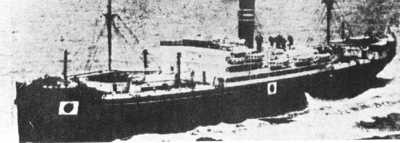
The Rakuyo Maru. (Photograph: United States Navy)

The Rakuyo Maru. (Photograph: United States Navy)
As the POWs climbed the gangway, Bill gazed at the distant shimmering hills. His determination to beat the odds, to survive no matter what, suddenly seemed to take on momentous proportions. He had come this far but now it seemed the odds were stacked well and truly against him. Japan was so far from Australia and his time in captivity had dramatically weakened his body and his resolve. Could he survive this, he wondered?
The Korean guards prodded the prisoners with pointed sticks, pushing them towards the Number 3 hold. They were forced down the stairs into the dark cavernous space. The air in their new ‘prison’ was stifling and very hot. The men tried to return to the deck. ‘No-one can survive down there. We’ll suffocate’, they clamored.
The guards moved in and began beating the beleaguered prisoners. ‘Speedo! speedo!’ they screeched as they shoved the POWs down the opening.
The ships sailed north where they were joined by other vessels from Manila. As the ships proceeded towards Japan they entered an area known to the American submariners as ‘Convoy College’.(4) Positioned between the Japanese ships and their destination were two American wolf packs -- ‘Ben’s Busters’, comprising USSGrowler, Pampanito and Sealion II and ‘Ed’s Eradicators’, USS Barb and Queenfish. (4)
At 5.22 am on 12 September, the Rakuyo Maru was being watched through the periscope of the USS Sealion II. As the image of the ship’s bow met the cross hairs of the periscope, the submarine’s captain calmly fired three torpedoes. Each of the deadly missile’s warheads carried 668 pounds (300 kg) of high explosive. TheRakuyo Maru was doomed.
The first torpedo slammed into the steel plates amidships, the second 200 feet (60 metres) aft of the Number 2 hold. The explosions were little more than dull thuds -- the force of the blast apparently absorbed by the closely packed rubber. Seawater now gushed into the hold causing some of the POWs to panic and rush the ladders.
Several of the non-commissioned officers (NCOs) took control of the situation by putting themselves between the panic-stricken mob and the ladder. When they realised that the ship was being held afloat by the rubber and was not in danger of sinking immediately, a more orderly system of evacuation was established. On deck, the Japanese raced to the lifeboats but refused access to the POWs, beating them away with sticks.(4)
The prisoners were left to fend for themselves. Another series of explosions lit up the night sky as torpedoes slammed into the accompanying tanker Nankai Maru. Meanwhile ten lifeboats had been swung away, all full of Japanese. As other Japanese ran around the ship in panic, a number of the POWs took the opportunity to settle a few old scores and soon the decks were littered with bloodied Japanese corpses.
Bill Webb assessed the situation and weighed up his options. He could chance staying on the ship until the last minute, but who was to say it would not be the target of another torpedo. In the water he had a chance of securing a position on a raft, where he could await being picked up by the Japanese whom he was sure would return for the survivors. Preferring the latter, Bill jumped from the ship.
The current swept him quickly away from the Rakuyo Maru, in the opposite direction to the rafts. Treading water, Webb found it difficult to stay afloat. ‘You bloody idiot’, he chided himself. ‘You should have stayed with the ship.’ In the distance Webb could see a man lying across a bundle of bamboo poles. Mustering his last skerrick of strength, Bill swam towards the man but he was in dire trouble. He was exhausted and every stroke he took tired him even more. His arms were barely clearing the surface and with every breath he swallowed more and more saltwater. Suddenly a pair of hands hauled him onto the bamboo. ‘What are you doing out here, Bill?’ asked a familiar voice. It was John Langley, another veteran of the railway labour camps.
The two agreed that it might be safer to return to the ship. With their upper torsos on the bamboo and their legs in the water, they kicked their way towards theRakuyo Maru. Six hours later the exhausted pair grabbed the rope ladder dangling from the side of the ship.(4)
Collapsing on the deck, Webb and Langley found several others had returned as well and actively were engaged in building a raft out of hatch covers. After scrounging some water, Webb and Langley offered to help. The ship was creaking and groaning as the seawater filled every crevice of the lower decks. Webb scurried through the upper deck cabins looking for anything useful.
He found a canteen of water and a large tin of flaked fish. On his way back to the others he stopped to rummage through the equipment of a couple of dead Japanese soldiers. He found a bottle of brandy, another bottle of water and a tin of biscuits. He passed the booty to his mates on the raft, took one last look around the deck then scurried down the ladder.
The raft had travelled barely 100 metres when the sinking Rakuyo Maru plunged 2000 metres to the bottom of the South China Sea. The time was 5.30 pm -- it had been a long, long day. Suddenly all eyes were directed to the horizon where two Japanese frigates and a Japanese merchant ship could be seen steaming toward the human flotsam.
The merchant ship slowed and then stopped, while the frigates patrolled in circles around both the ship and the dirty, oil-soaked survivors -- both prisoners and Japanese. The Allied survivors attempted to climb the rope ladders but they were beaten away by the Japanese crewmen. Slowly the propellers of the merchant ship began to turn and the ship pulled away from the horrified Diggers. ‘Killers! Why don’t you pick us up?’ they shouted. The men watched in utter despair as the ships disappeared over the horizon.
It was getting dark as the POWs sought refuge in the vacated lifeboats. Webb and his cobbers were foundering on the home-made raft but they could see the lifeboats in the distance. ‘Come on lads, let’s try a loud bush coo-ee!’ The call echoed across the waters, but no response was heard. They tried again and ever so faintly they heard it.
‘Coo-eeee! Coo-eeeee!’ The men in the lifeboats had heard their cry for help and were on their way. A group of three lifeboats arrived and Webb and his mates were dragged aboard. The boats were under command of electrical artificer Vic Duncan, who had survived the sinking of HMAS Perth in 1942. In another of the boats was the Australian commander, Brigadier Varley.(4)
The Diggers now pondered their fate. Duncan was fairly sure that they were some 500 kilometres from the China coast (they were actually only 350). He was confident that, by using dead reckoning, if they rowed continuously, they would reach the coast within eight to ten days. The men took a vote. Some opted to stay and take a chance on the Japanese sending a ship back for them; others, including Varley and Webb, chose to go with Duncan. John Langley, Bill’s ‘railway’ mate, decided to remain and take his chances.
By 14 September 1944, the 136 POWs crowded into the four boats of Duncan’s group had made sound progress. It was their third day of freedom and they believed that the coast was just over the horizon. The six boats of Varley’s group had broken away the day before and were about ten kilometres away but still keeping pace. Suddenly Webb called to Duncan, ‘Smoke on the horizon’.
Three Japanese corvettes made their way toward Varley’s group. As the men watched, prolonged bursts of continuous machine-gun fire could be heard. Webb could do little else but assume that the Japanese were machine-gunning the survivors in Varley’s six lifeboats.
As the corvettes steamed toward Duncan’s group, the soldiers had little doubt they were about to suffer the same fate as their mates. They calmly said their good-byes and awaited the inevitable. One of the corvettes peeled off and, with guns fully manned, slowed as it came alongside the lifeboats. Vic Duncan told the men, ‘If you believe in God, say your prayers now’.
‘Are you American?’ came the question from the direction of the ship.
‘No,’ replied the POWs.
‘Are you British?’
‘No, we’re Australian,’ shouted the prisoners.
Then, to the utter amazement of Webb and the others, a rope ladder tumbled down the side of the ship. As the last of the POWs climbed aboard, the ship slowly picked up speed. They were taken to the small harbour of Sangai, on the island of Hainan where they were transferred to a Japanese whaling ship bound for Japan.
For the remainder of the war, Webb and the other POWs were destined to work in Japanese coalmines and shipyards. The work was hard and the rations lean, but after the treatment and conditions they had endured in earlier camps, and their time spent in the sea struggling to survive, it was akin to a holiday.
Webb was finally freed in September 1945 when units of the American Occupation Forces burst through the gates of Karasaki POW Camp. As a bedraggled Webb grasped the hand of a young American soldier he said jokingly, ‘You took your bloody time getting here, didn’t you mate?’
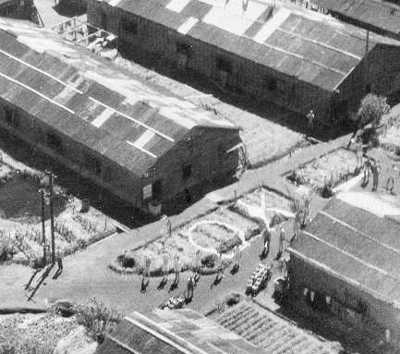
Like to copy this image? Please click here first
AWM 305348. Yokohama, Japan. August 1945. Aerial view of a Prisoner of War Camp where Allied Prisoners of War have made the letters OK in their compound from pieces of material as an indication of their condition.
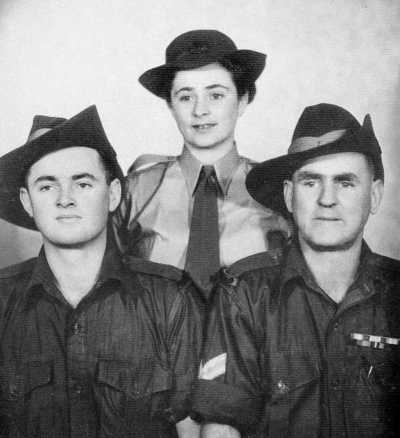
Like to copy this image? Please click here first
AWM P01361.002. Father and his two children, all in uniform. Left to right: Private John (Jack) Webb, Private Shirley Webb, and Corporal William Purnell Webb, 2/3rd Motor Transport Company, following his return from Japan. He had served in World War 1 and was a prisoner of war (POW) on the Burma railway 1942.
The US submarines retraced their course after the sinking of the two prison ships and rescued 92 Australian and 60 British prisoners. They brought back the first information of the Japanese atrocities on the Burma-Thailand Railway. One of the prisoners who was rescued was John Langley, the man who had pulled Bill Webb onto the bamboo raft.(5)
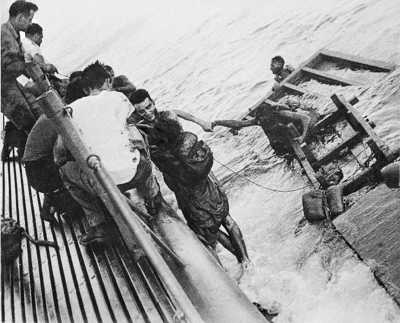
Like to copy this image? Please click here first
AWM 305634. China Sea. Oil-soaked British and Australian prisoners of war who survived the sinking of the Japanese transport Rakuyo Maru by the submarine USS Sealion, being picked up three days later by that submarine.
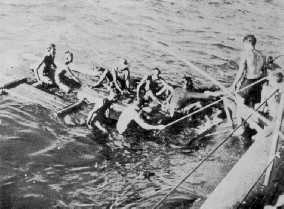
Like to copy this image? Please click here first
Pampanito crew prepare to take aboard survivors. (Photograph: United States Navy, Paul Pappas)
Footnotes
1 National Archives of Australia: WW2 Service Records, QX12962 Private William Purnell Webb
2 Wigmore L, Official History of Australia in the Second World War Vol IV: The Japanese Thrust, Australian War Memorial, Canberra, 1957
3 Blair J & C, Return from the River Kwai, Macdonald and Jane’s, London, 1979
4 Wheeler, K, War Under the Pacific, World War II Series, Time Life Books, USA, 1980
5 Public Records Office, London, interviews with POWs recovered by U.S. submarines





